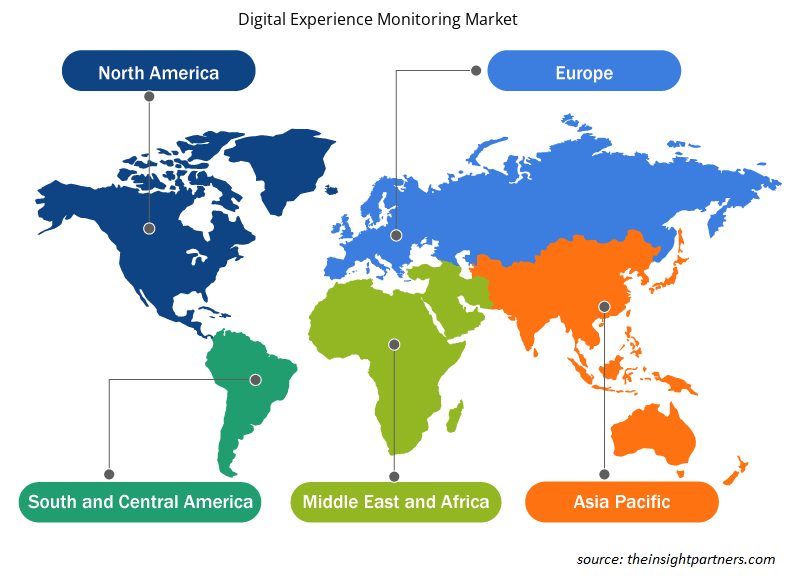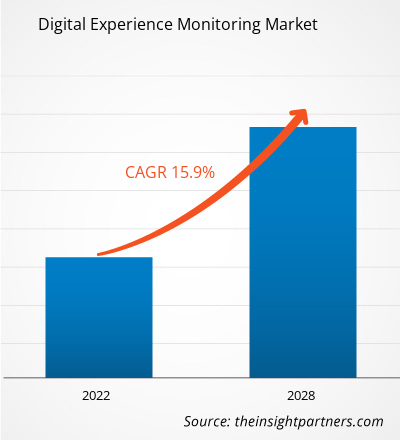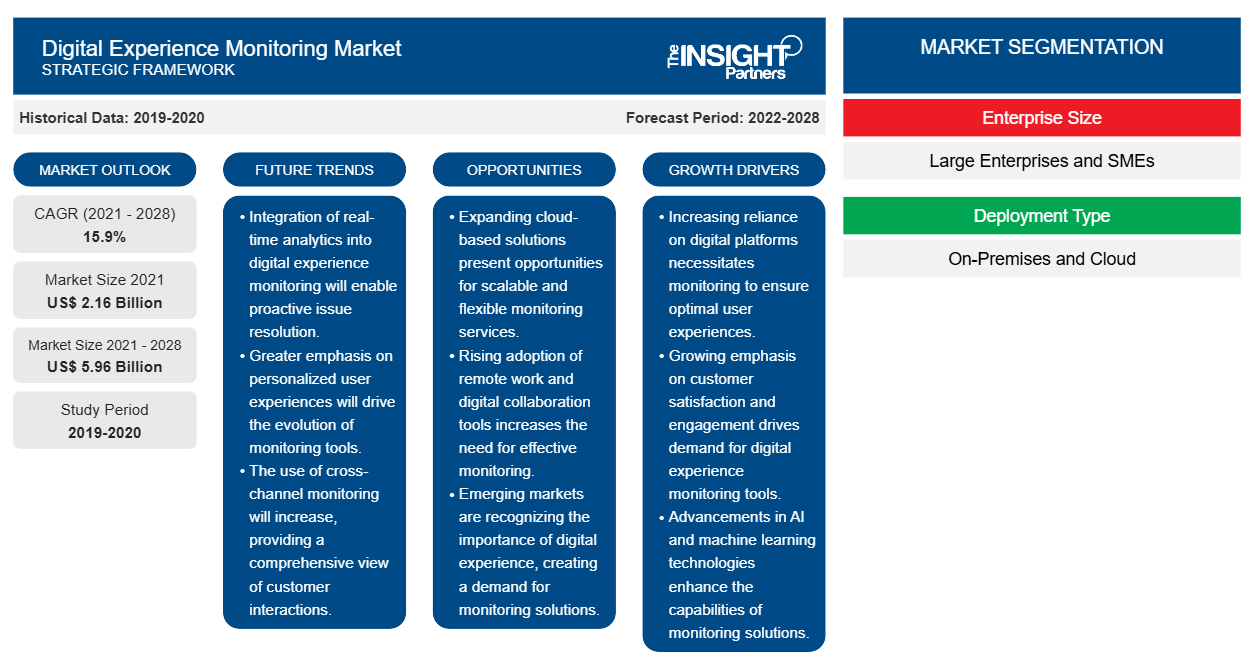Si prevede che le dimensioni del mercato del monitoraggio dell'esperienza digitale cresceranno da 2.156,71 milioni di dollari nel 2021 a 5.960,87 milioni di dollari entro il 2028. Si stima che le dimensioni del mercato del monitoraggio dell'esperienza digitale cresceranno a un CAGR del 15,9% dal 2022 al 2028.
Il monitoraggio dell'esperienza digitale (DEM) è una nuova tecnologia che le aziende stanno prendendo in considerazione come metodo per semplificare i problemi di prestazioni degli utenti, ottenendo al contempo informazioni su una gamma di tecnologie di rete con un'unica soluzione. La progressione del monitoraggio delle prestazioni delle applicazioni (APM) e del monitoraggio dell'esperienza dell'utente finale (EUEM) in una soluzione olistica che valuta l'efficacia delle applicazioni e dei servizi di un'azienda è DEM. DEM è una soluzione di monitoraggio in tempo reale che aiuta i team delle operazioni IT a risolvere tempestivamente i problemi degli utenti, garantendo al contempo che la rete non venga disturbata. Le tecnologie di monitoraggio delle prestazioni delle applicazioni (APM) e di monitoraggio e diagnostica delle prestazioni di rete (NPMD) esistenti possono essere integrate con soluzioni DEM. Se utilizzate insieme, forniscono una visione end-to-end, con DEM che fornisce informazioni sull'esperienza utente. Queste sono le esperienze che hanno l'impatto più diretto sui risultati aziendali. DEM è uno strumento di monitoraggio in tempo reale che aiuta la "macchina" della tua azienda a funzionare senza problemi, scoprendo le vulnerabilità che causano tempi di inattività o disturbi all'esperienza utente, come tempi di caricamento delle pagine scadenti, e determinando la causa sottostante delle prestazioni. Il software DEM monitora il comportamento degli utenti, il traffico e altri fattori per aiutare le aziende a comprendere l'usabilità e le prestazioni del prodotto. I prodotti DEM integrano il traffico attivo o simulato e il monitoraggio degli utenti reali per analizzare le prestazioni teoriche e l'esperienza reale dell'utente. Questi strumenti forniscono strumenti analitici per esaminare e migliorare le prestazioni dell'applicazione e del sito. Aiutano inoltre le aziende a comprendere come i visitatori navigano nel loro sito e a scoprire dove l'esperienza dell'utente finale sembra risentirne.
L'esame dei dati sulle prestazioni su dispositivi, app, infrastrutture e servizi per comprendere in che modo le interazioni degli utenti finali con la tecnologia influenzano la qualità della loro esperienza digitale è noto come DEM. L'IT può tracciare e valutare vari parametri che influenzano gli utenti, tra cui CPU, memoria, utilizzo dell'hardware, latenza, prestazioni del software e altro, utilizzando il monitoraggio dell'esperienza digitale. Queste misurazioni, che vengono raccolte costantemente dall'endpoint e abbinate all'analisi cognitiva e all'automazione, possono aiutare l'IT a diagnosticare, risolvere e persino prevedere tempestivamente i problemi senza che l'utente ne sia a conoscenza. Feedback e opinioni possono anche indicare elementi che le statistiche dell'endpoint non possono catturare. Le soluzioni di monitoraggio dell'esperienza digitale vanno oltre il tipico monitoraggio delle prestazioni di rete e applicazione per scoprire problemi di rete che possono influenzare le prestazioni del servizio basato su cloud. Questo fattore sta influenzando la crescita del mercato del monitoraggio dell'esperienza digitale .
Personalizza questo report in base alle tue esigenze
Riceverai la personalizzazione gratuita di qualsiasi report, comprese parti di questo report, o analisi a livello nazionale, pacchetto dati Excel, oltre a usufruire di grandi offerte e sconti per start-up e università
-
Scopri le principali tendenze di mercato in questo rapporto.Questo campione GRATUITO includerà analisi di dati che spaziano dalle tendenze di mercato alle stime e alle previsioni.
Impatto della pandemia di COVID-19 sul mercato del monitoraggio dell'esperienza digitale
Con l'emergere della pandemia di COVID-19, l'intero settore dell'aviazione si è fermato in modo imprevisto. Turchia, Iran, Sudafrica, Iraq, Israele, Arabia Saudita ed Emirati Arabi Uniti hanno segnalato un gran numero di casi confermati di COVID-19 e decessi. Il mercato del monitoraggio dell'esperienza digitale comprende importanti economie, come Emirati Arabi Uniti e Arabia Saudita, che sono potenziali fornitori nel settore del monitoraggio dell'esperienza digitale a causa dell'enorme presenza di una base di clienti diversificata. Prima della pandemia, i paesi del Golfo erano sul punto di adottare tecnologie digitali trasformative in vari settori verticali per migliorare le condizioni socio-economiche dei paesi. Tuttavia, a causa dello scoppio del COVID-19, l'implementazione di misure rigorose come blocchi di fabbriche, chiusure di attività e restrizioni di viaggio ha aggravato i problemi economici dei paesi, come il MEA. Pertanto, le condizioni economiche del MEA e l'impatto della pandemia di COVID-19 sulla crescita di vari settori nella regione hanno influenzato leggermente la crescita del mercato del monitoraggio dell'esperienza digitale nel 2020.
Approfondimenti sul mercato del monitoraggio dell'esperienza digitale
Il sistema di feedback dei clienti, fondamentale per qualsiasi settore di monitoraggio dell'esperienza digitale funzionale e redditizio, è stato migliorato grazie ai miglioramenti tecnologici nel mercato del monitoraggio dell'esperienza digitale. Ad esempio, le aziende stanno implementando un sistema di feedback online utilizzando un Customer Relationship Management (CRM) all'avanguardia. Di conseguenza, l'input del cliente aiuta direttamente a effettuare modifiche in tempo reale e ad aggiornare il software aziendale per condurre una valutazione in tempo reale della qualità e adattare o cambiare secondo necessità. Qualsiasi azienda che stia sperimentando una transizione digitale deve implementare sistemi di monitoraggio dell'esperienza. Semplificare le procedure digitali coinvolte nella gestione di un'azienda getta solide basi per futuri cambiamenti di sistema o innovazione continua. Questo sta guidando il mercato del monitoraggio dell'esperienza digitale.
Approfondimenti di mercato basati sulle dimensioni aziendali
Analisi di mercato del monitoraggio dell'esperienza digitale in base alle dimensioni aziendali, il mercato è segmentato in grandi aziende e PMI. Nel 2021, il segmento delle grandi aziende ha rappresentato una quota di mercato maggiore del monitoraggio dell'esperienza digitale.
Informazioni di mercato basate sul tipo di distribuzione
Analisi di mercato del monitoraggio dell'esperienza digitale per tipo di distribuzione, il mercato è segmentato in on-premise e cloud. Nel 2021, il segmento cloud ha rappresentato una quota di mercato maggiore del monitoraggio dell'esperienza digitale.
I giocatori adottano strategie, come fusioni, acquisizioni e iniziative di mercato, per mantenere le loro posizioni nel mercato. Di seguito sono elencati alcuni sviluppi dei giocatori chiave nel mercato:
- Nel 2022, BMC ha annunciato nuove funzionalità e integrazioni nei suoi portafogli BMC AMI (automated mainframe intelligence) e BMC Compuware. Le innovazioni aiutano i clienti a migliorare la qualità del servizio e ad accelerare la distribuzione del software offrendo una maggiore visibilità dei dati e approfondimenti basati sul contesto nei loro ambienti IT.
- Nel 2021, Broadcom Inc. ha acquisito AppNeta per rafforzare il monitoraggio delle prestazioni di rete su Internet e sulle applicazioni basate su cloud ibrido. Combinando la visibilità end-to-end di AppNeta con le pluripremiate e comprovate capacità di Broadcom in materia di infrastruttura e AIOps, le più grandi aziende al mondo che gestiscono le reti più complesse avranno ora accesso a un'unica fonte di verità per supportare il loro percorso nel cloud.
Approfondimenti regionali sul mercato del monitoraggio dell'esperienza digitale
Le tendenze regionali e i fattori che influenzano il mercato del monitoraggio dell'esperienza digitale durante il periodo di previsione sono stati ampiamente spiegati dagli analisti di Insight Partners. Questa sezione discute anche i segmenti e la geografia del mercato del monitoraggio dell'esperienza digitale in Nord America, Europa, Asia Pacifico, Medio Oriente e Africa e America centrale e meridionale.

- Ottieni i dati specifici regionali per il mercato del monitoraggio dell'esperienza digitale
Ambito del rapporto di mercato sul monitoraggio dell'esperienza digitale
| Attributo del report | Dettagli |
|---|---|
| Dimensioni del mercato nel 2021 | 2,16 miliardi di dollari USA |
| Dimensioni del mercato entro il 2028 | 5,96 miliardi di dollari USA |
| CAGR globale (2021 - 2028) | 15,9% |
| Dati storici | 2019-2020 |
| Periodo di previsione | 2022-2028 |
| Segmenti coperti |
Per dimensione aziendale
|
| Regioni e Paesi coperti |
America del Nord
|
| Leader di mercato e profili aziendali chiave |
|
Monitoraggio dell'esperienza digitale Densità degli attori del mercato: comprendere il suo impatto sulle dinamiche aziendali
Il mercato del Digital Experience Monitoring Market sta crescendo rapidamente, spinto dalla crescente domanda degli utenti finali dovuta a fattori quali l'evoluzione delle preferenze dei consumatori, i progressi tecnologici e una maggiore consapevolezza dei vantaggi del prodotto. Con l'aumento della domanda, le aziende stanno ampliando le loro offerte, innovando per soddisfare le esigenze dei consumatori e capitalizzando sulle tendenze emergenti, il che alimenta ulteriormente la crescita del mercato.
La densità degli operatori di mercato si riferisce alla distribuzione di aziende o società che operano in un particolare mercato o settore. Indica quanti concorrenti (operatori di mercato) sono presenti in un dato spazio di mercato in relazione alle sue dimensioni o al valore di mercato totale.
Le principali aziende che operano nel mercato del monitoraggio dell'esperienza digitale sono:
- AppDynamics LLC
- Azienda
- Società per azioni Broadcom Inc.
- Sistemi Catchpoint, inc.
- Dynatrace LLC
Disclaimer : le aziende elencate sopra non sono classificate secondo un ordine particolare.

- Ottieni una panoramica dei principali attori del mercato del monitoraggio dell'esperienza digitale
Profili aziendali nel rapporto di mercato sul monitoraggio dell'esperienza digitale
- Azienda
- Società per azioni Broadcom Inc.
- Tecnologie di controllo Up LTD
- Software di Lakeside, LLC
- Aternity LLC
- Nexthink SA
- AppDynamics LLC
- Sistemi Catchpoint, inc.
- Dynatrace LLC
- Società IBM
- Micro-messa a fuoco
- Società Oracle
- Azienda
- SAP SE
- Analisi storica (2 anni), anno base, previsione (7 anni) con CAGR
- Analisi PEST e SWOT
- Valore/volume delle dimensioni del mercato - Globale, Regionale, Nazionale
- Industria e panorama competitivo
- Set di dati Excel
Report recenti
Rapporti correlati
Testimonianze
Motivo dell'acquisto
- Processo decisionale informato
- Comprensione delle dinamiche di mercato
- Analisi competitiva
- Analisi dei clienti
- Previsioni di mercato
- Mitigazione del rischio
- Pianificazione strategica
- Giustificazione degli investimenti
- Identificazione dei mercati emergenti
- Miglioramento delle strategie di marketing
- Aumento dell'efficienza operativa
- Allineamento alle tendenze normative























 Ottieni un campione gratuito per - Mercato del monitoraggio dell'esperienza digitale
Ottieni un campione gratuito per - Mercato del monitoraggio dell'esperienza digitale